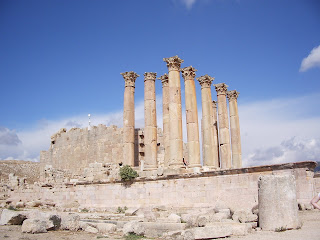...Not very far.

We went into the West Bank last week to visit Bethlehem University as well as the Church of the Nativity. There are a whole slew of things we could discuss regarding Bethlehem in relation to the West Bank, but I'd rather discuss Bethlehem in relation to religion.
The Church of the Nativity is built above the site where the Christian world believes that Jesus Christ was born. Small tangent, often when we visit these sites I'm rather skeptical as to whether or not the events really did happen where the people say they did. Most of the things we discuss happened so long ago there really isn't any way they can say for certain if it is the correct place or not. However, the Church of the Nativity is different. It was a first century belief that this was the site of His birth, and when Constantine's mother Helena came to the Holy Land in the third century she decided that was correct and the first church was built there.
The church itself has beautiful columns and windows, and the original church had an amazing mosaic floor which is partly visible inside. However, the most interesting part of the structure, to me, is the roof. The roof is a very old wooden structure, and it has been threatening to collapse for a while now. Every tour group that goes to the church is in danger of being trapped underneath a fallen roof, however it has not yet been replaced. Why, you ask? Well, the Church of the Nativity is run by three religions: Greek Orthodox, Armenian, and Roman Catholic. The Armenian and Roman Catholic churches believe that the three each have 33% control of the church, however the Greek Orthodox argue that they have 80% and the other two have 10%. Therein lies the problem: the Greek Orthodox want to pay 80% of the roof replacement bill, but the Armenians and Roman Catholics strongly oppose this as they each are only 33% responsible. Thus, the roof goes unfixed and will remain that way until it
collapses on a group of Korean tourists or the Palestinian government steps in and replaces it themselves (which would cause another set of problems as none of the religions want the government to get involved).
It seems like a ridiculous situation, but it is very common in the Holy Land. There are stories like this about practically every Christian site you can imagine.
Once you go through the church you can go down into the grotto where Jesus was born. There is a star on the floor marking his birthplace and a little alcove where the manger would have lain. How the Greek Orthodox know exactly where Jesus was born within the grotto is a
mystery to me, but apparently they do. We were also able to go inside the caves where Saint Jerome translated the Vulgate Bible, the first copy to be written in Latin, which is the basis for many versions that we have today, including the King James. There is a statue of Jerome outside the church as well.
All in all, I really liked the Church of the Nativity. I am impressed with the Christian world's desire to commemorate important events on site by building magnificent churches. We have seen dozens already, and we get to see so many more this week in Galilee.
I'll be in Galilee for the next 11 days, so don't expect another post until the very end of November. However, I really will write about Galilee when we get back instead of waiting two weeks like I usually do. However, in my defense, we did have five finals and five essays, plus three field trips and I had to learn two piano pieces. It was a busy two weeks.














